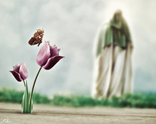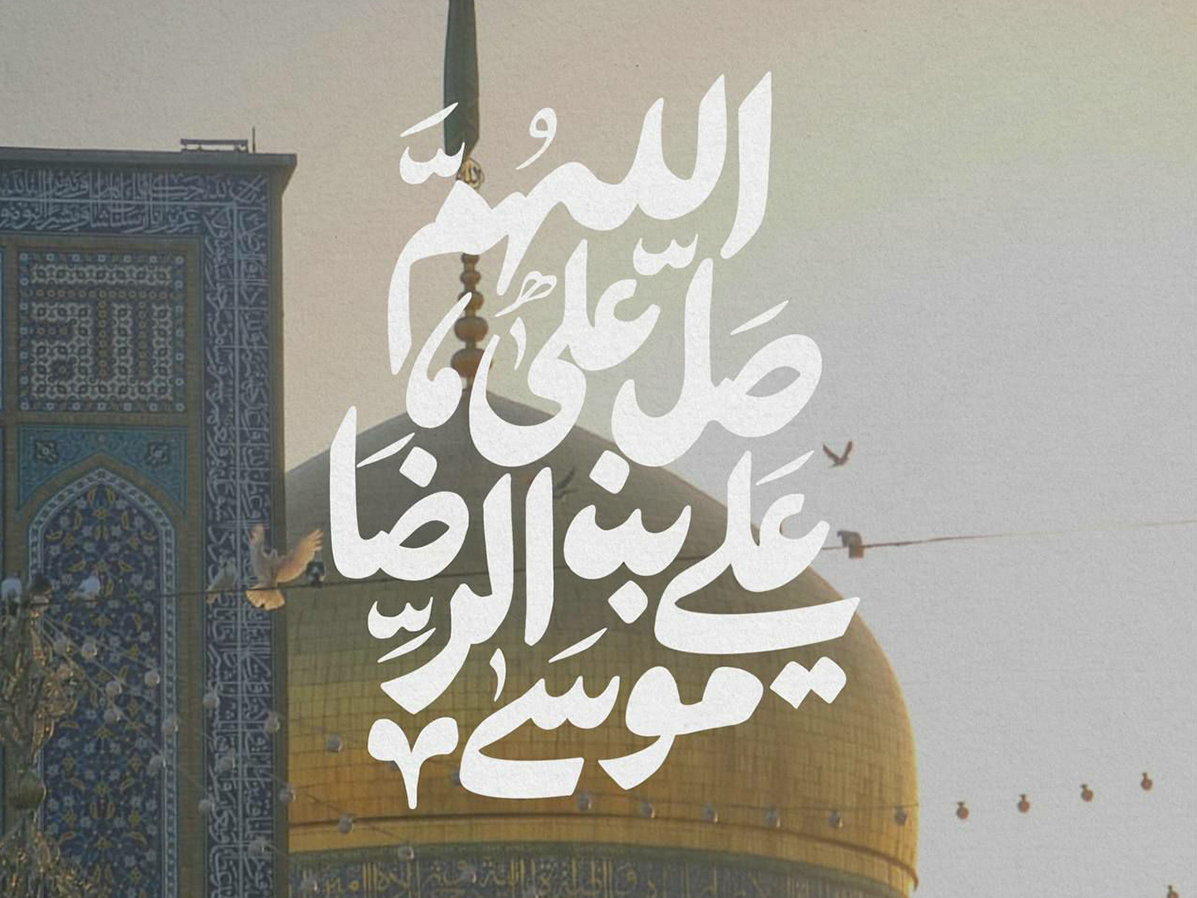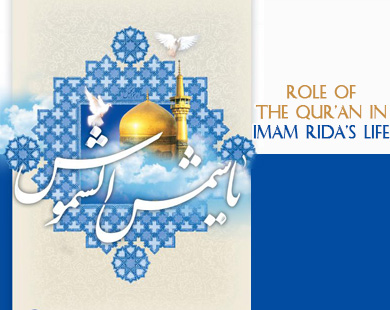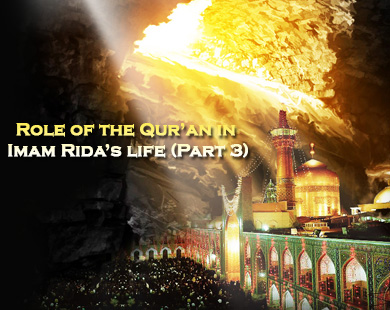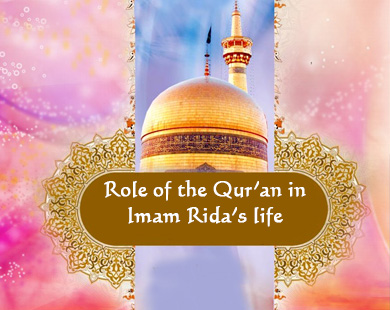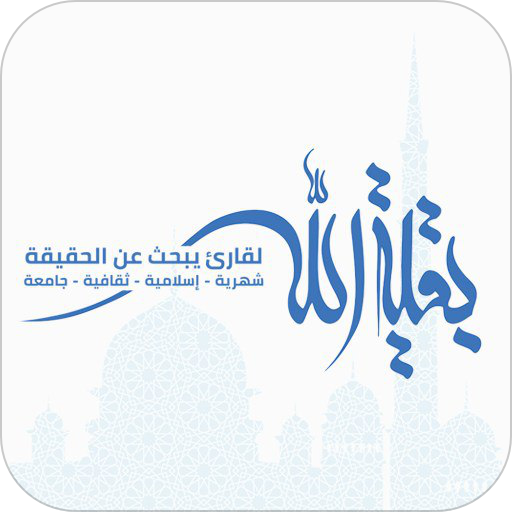The magnificent and marvellous buildings and structures in the holy shrine of Imam Rida (A.S.) situated in the holy city of Mashhad, Iran, comprises one of the oldest and most beautiful religious and historical monuments in the world. The visitors, travelers and historians have called this religious complex as "The Glory of the Islamic World".
The grand complex of the holy shrine is round in structure which includes six courtyards (Sahn), twenty - three porches (Riwaq), the Gowhar shad Mosque, Razavi University of Islamic Sciences, Islamic Research Foundation, Museums, the Central Library Complex, Offices, Hospital, Inn and the buildings for performing ablutions. The present surface area of the holy shrine is 267079 sq. meters. The holy burial chamber is connected to a network of twenty three Riwaqs (porches) covering an area of 5638 square meters. Riwaqs are the roofed buildings with different heights and designs built around the holy burial chamber during various phases of one thousand and two hundred years long history of the holy shrine.
After the twenty one Riwaqs there are ten Sahn (Courtyards) and four Bast (the Sanctuary) around the holy shrine which occupies a total area of 331578 square meters.
Sahn (courtyard) are the magnificent buildings within the holy shrine where the pilgrims perform religious services like congregational prayers, anniversary ceremonies of martyrdoms and birthdays of the Infallible Imams (A.S.). The courtyards are very magnificent and distinguished and known as the alive history of the crafts of their architects. Spectators, observing these historical art-works would dream of them done by expert the architects.
The ten Sahn (Courtyards) are as follows:
1.Sahn Inqilab (Revolution Courtyard)
2.Sahn Azadi (Freedom Courtyard)
3.Sahn Imam Khomeini (R.A.)
4.Sahn Gowharshad Mosque
5.Sahn Quds
6.Sahn Jumhuri Islami (Islamic Republic Courtyard)
7.Sahn Jameh Razavi (The Razavi Grand Courtyard)
8.Sahn Hidayat
9.Sahn Rizwan
10.Sahn Kawsar
The four Bast (the Sanctuary) are as follows:
1.Bast Shaykh Toosi (Upper Bast)
2.Bast Shaykh Tabarsi
3.Bast Shaykh Hur Ameli (Lower Bast)
4.Bast Shaykh Baha'i
Naqqar Khanah
Beating kettle-drums (Naqqarah) was customary in olden times upon the occurrence of an important event or the attendance of people in royal courts. In 860 A.H./ 1455 A.D., when Baisonqor, Shahrukh Mirza's son, the Timurid Sultan, came to Mashhad from Herat, kettle-drums were beaten to announce his presence in the holy shrine. He was visiting the holy shrine in order to find a cure for his illness which the physicians were unable to cure. Baisonqor was miraculously healed in the holy shrine and the kettle-drums were beaten once again, and since then, this practice is performed everyday before sunrise and sunset (except the mourning periods). The kettle-drums are also beaten when any sick pilgrim gets miraculously healed at the holy shrine.
Saqqa Khaneh
In the school of Shi'ism,the concept or application of Saqqa Khaneh (the public place for drinking water) is more significant than merely serving water. The Shi'ites who endeavour to honour and commemorate the tragical event of Karbala and the martyrdom of His Holiness Imam Hussein (A.S.) and that of his loyal companions, who were martyred after remaining thirsty for three complete days. In the middle of the Sahn-i Inqilab the famous Saqqa Khaneh known as Saqqa Khaneh-i Ismail Talaie is situated. It was constructed during the reign of Nader Shah Afshar. The upper parts of its arches are covered with golden inscriptions, the work of an craftsman called Ismail. For this reason the Saqqa-Khaneh is also referred to as Saqqa Khaneh Ismail Talaie. The Saqqa-Khaneh is hexagonal in shape and carved from a single-piece of marble. On the order of Nader Shah Afshar the marble was brought from Herat and was installed on the floor of the fountain. There is a Saqqa Khaneh in the middle of the Sahn Quds, which was inaugurated in 1990. This Saqqa Khaneh is built in the shape of Masjid-i Aqsa, the first Qeblah (direction faced in the prayers) of the Muslims, situated in Jerusalem. This beautiful drinking water repository occupies 1/8 of the
area of the original Masjid-i Aqsa in Jerusalem. The exterior of it features the architecture and mosaic tile work of Aqsa Mosque and its dome is completely made up of gold.
Opposite to the Golden Ivan of the Sahn Jumhuri Islami (Islamic Republic Courtyard) there is a beautiful Saqqa Khaneh. This beautiful building is octagonal in shape with a golden dome and its exterior is covered with mosaic tiles. The water supply in this Saqqa Khaneh is through electronic system. The Islamic Republic Courtyard is the second largest courtyard of the holy shrine and was inaugurated in 1990.
The Tomb of Shaykh Hur Ameli
In the north-eastern part of the Inqilab Courtyard is the tomb of the prominent Shi'ite scholar, Shaykh Hur Ameli. Muhammad ibn Hassan ibn Ali ibn Muhammad ibn al-Hussein Hur Ameli, the famous Shi'ite theologian and traditionist, whose genealogy traces back to Hur ibn Yazid al-Riyahi was born in 1033 A.H./1623 A.D., and expired in 1104 A.H./1692 A.D. Shaykh Hur Ameli compiled 22 books, the most famous is "Wasa'el ush-Shia", a great collection of Shia Ahadith. His tomb is located in the north-eastern part of the Inqilab Courtyard on the side of Madrasah Mirza Jafar. Shaykh Hur Ameli's tomb was renovated in 1984 A.D. by Astan Quds Razavi.
Gowharshad Mosque
The Gowharshad Mosque, situated in the southern part of the holy shrine is one of the beautiful and glorious mosques in the world. This mosque is situated between the Bast Shaykh Baha'i and Sahn Imam Khomeini (R.A.). It was built in 821 A.H./1418 A.D., on the orders of Gowharshad Agha, wife of Shahrukh Mirza, the Timurid Sultan. The Gowharshad Mosque enjoys a particular spiritual reputation among the Islamic mosques in the world. In addition to receiving many pilgrims of Imam Rida (A.S.) during the year, this mosque has been a centre of learning and teaching the Islamic Sciences since last six centuries. The high-ranking Ulama lecture Islamic Sciences in this mosque and in the Shabistans (prayer halls) of the mentioned mosque.
Sahn Quds
This newly constructed courtyard built on the replica Aqsa Mosque in Jerusalem lies on the southern side of the Gowharshad Mosque between the Bast Shaykh Baha'i, part of Sahn Imam Khomeini (R.A.) and the Razavi Grand Courtyard (Sahn Jameh Razavi). It is the smallest courtyard of the holy shrine.
Sahn Jameh Razavi
The recently constructed grand courtyard in the holy shrine is called as Sahn Jameh Razavi. It is the largest courtyard of the holy shrine and occupies an area of 57000 square meters which includes its Shabistans and chambers. It is located in the Qeblah direction of the Gowharshad Mosque looking towards Imam Rida (A.S.) avenue. The large open area of this grand courtyard is for the performance of Friday prayers, daily congregational prayers, supplications and other religious gatherings.
Astan Quds Razavi Central Library
It is the most important and the largest library in the Islamic world. This historical library was founded in 363 A.H. /973 A.D., about 1027 years ago. There is a copy of the Holy Quran preserved in the library endowed by Muhammad ibn Kathir, the minister of Sultan Mahmud of Ghazni dating back to the year 393 A.H./1002 A.D.
At present this library is furnished with half a million copies of books, and can store about five million copies in its spacious stores. The available books are in 46 currently spoken languages including 32485 rare manuscripts, 1000 albums and 36000 microfilms from the rare manuscripts of home and abroad.
There are 12000 hand written copies of the Holy Quran in the library. This is the largest collection of handwritten copies of the Holy Quran in the world. Some of the handwritten copies of the Holy Quran are attributed to be written by Shi'ite Holy Imams like Imam Ali (A.S.), Imam Hassan (A.S.), Imam Hussein(A.S.), Imam Sajjad (A.S.) and Imam Rida (A.S.) on the deer skin. The rare collection of the handwritten copies of the Holy Quran are displayed in the "Quranic Treasure Museum" situated within the precincts of the holy shrine.
The extraordinary preciousness of the exquisite copies of the Glorious Quran and that of matchless manuscripts as well as printed books preserved in this library have provided universal fame and credit for this cultural centre throughout the world.
A three - storeyed new complex for the library constructed on an area of 11000 sq meters is also considered as the miracle of Islamic architecture has been recently inaugurated and occupies an area of 28000 sq.meters. It is located at the northern side of bast Shaykh Toosi. (known as Bast-i Bala i-e Upper Bast). The architecture of new complex of the library is completely based on beautiful and intrinsic Islamic style.
There are different reading rooms allotted for men, women and children in this library which is also equipped with and audio-visual room, as well as rooms for men and women researchers. It is equipped with all the necessary sophisticated equipments needed for preserving the manuscripts. The library is centrally computerized with well furnished reading rooms, laboratories, treasure for rare manuscripts completely immune to all forms of disasters, conference hall, various specialized sections for newspapers and magazines, archives, calligraphy, traditional book - binding and casing, illuminating (gilding), painting (miniaturing) and designing of books.
Razavi University of Islamic Sciences
It is situated in the north of the Inqilab Courtyard (Sahn Atiq) and east of Bast Shaykh Tabarsi and occupies a total area of 22000 square meters.
After the victory of the Islamic Revolution in Iran in 1979 the Mirza Jafar and Khairat Khan Islamic seminaries situated within the precincts of the holy shrine were rebuilt. Its ancient parts built during the Safavid period had been preserved and renovated and some new buildings have been added which altogether comprise the new Islamic university complex known as "Razavi University of Islamic Sciences." The new four floored grand complex is built in traditional Islamic architecture which includes 22 classrooms, two amphitheatres, 250 bedrooms, library and some other essential facilities. This Islamic university was inaugurated on 11th Zee -al Qa'dah, 1404 A.H./ 8 August, 1984 on the birthday anniversary of Imam Rida (A.S.).
Islamic Research Foundation
The Islamic Research Foundation (briefly known as IRF) was established on Nov 12, 1984. On May 9,1985, it was registered under No. 178 in Companies Registration Office in Mashhad, and started its activities right away. At present IRF is operating as a research and scholarly center affiliated to the Astan Quds Razavi Supreme Cultural Council, supervised by IRF's Board of Directors, and with the cooperation of researchers from Hawzah (Islamic Seminary) and universities in different research departments, aiming at the realization of the cultural goals of the Astan Quds Razavi. It has already published more than one thousand titles of books on various Islamic sciences.
Museums of the Astan Quds Razavi
The museums of the Astan Quds Razavi are among the richest museums of Islamic Republic of Iran, and are included among the most important art and cultural centers of the Islamic world.
The Astan Quds Razavi have several active museums which are as follows:
A) Central Museum:
B) Qur'anic Treasure Museum:
C) The Museum of the Gifts Presented by the Paramount Leader of the Islamic Republic of Iran to the Astan Quds Razavi:
D) Stamp Museum:
E)The Museum of the History of Mashhad:
F)The Museum of the Finest Carpets:
The Islamic Seminaries At The Holy Shrine
There are four famous historical Islamic seminaries situated within the precincts of the holy shrine.
1. Madrasa Bala Sar
2- Madrasa Do-Dar
3-Madrasa Parizad
4-Madrasa Nawab
Welfare Facilities
1) Imam Rida (A.S.) Hospital (Dar-al-Shifa).
Imam Rida (A.S.) Hospital known as Dar al-Shifa-e- Imam (A.S.) renders medical services to the pilgrims on non-profit basis. It is located on the southern side of the Bast Shaykh Hur Ameli (Lower Bast) and opposite to the Astan Quds Razavi Inn. This two floored hospital occupies an area of 22000 square meters and was inaugurated in 1981.
2) Astan Quds Razavi's Inn:
The foreign and local pilgrims are served lunch at the Inn free of charge. To be the guest of Imam Rida (A.S.) at the Inn the "Foreign Pilgrims" should take their passports to the office located beside the tomb of Shaykh Hur Ameli at the Inqilab Courtyard and obtain the necessary coupons.
3) Consignment Offices:
These offices are located in the Inqilab, Azadi, Imam Khomeini (R.A.) and the Islamic Republic Courtyards, as well as in some Riwaqs inside the holy shrine and at the entrances for the convenience of the pilgrims in order to keep their personal valuable belongings and objects as long
as they wish.
4) Endowments Office:
For receiving the offerings and endowments from the pilgrims many endowments offices have been established in the holy shrine. These offices are located in Dar al-Sharaf, Dar al-Vilayah and Dar al-Suroor porches and Inqilab, Gowharshad Mosque, Imam Khomeini (R.A.) and Azadi Courtyards.
Receipts are given to the donors after receiving the endowments in cash or kind. There is also a chamber in the Inqilab Courtyard which sells wheat for the feeding of pigeons at this courtyard.
5) Offices Dealing with Missing Persons and Objects:
The offices dealing with the missing persons and objects are located in the Inqilab and Jumhuri Islami courtyards. The identities of those missing are regularly announced through the loud speakers of these offices.
6) Offices of Religious Affairs:
These offices are located in the Azadi and Gowharshad Mosque courtyards. These offices gives replies to all the religious issues. There is an office in the Azadi courtyard to collect the religious funds (Khums, Zakat etc.) and legal alms (Sadaqat).
7) Security Office:
A Security Office is located at Inqilab Courtyard and handles disciplinary affairs and possible social abuses such as theft.
8) Office For Assisting Pilgrims:
This office is located at the Inqilab Courtyard to provide help and assistance in cash or kind to the pilgrims.
9) Office for other Religious Affairs.
A) Office of the Prayers Leaders of the holy city of Mashhad is situated in the Gowharshad Mosque Courtyard.
B) Office of the Religious Groups of the holy city of Mashhad is situated in the Inqilab Courtyard.
C) Office of the Pilgrims Healed Miraculously is located in the Inqilab Courtyard. It registers and maintains a record of pilgrims who have been miraculously cured in the holy shrine by Imam Rida (A.S.).
D) A pavilion is situated in the Gowharshad Mosque to teach the art of the recitation of the Holy Quran.
10) Administrative Affairs Offices:
A) Office of the Cultural Affairs of the holy shrine is situated in the Islamic Republic Courtyard.
B) International Relations Office:
It deals with the affairs of the non-Iranian pilgrims and its office is situated in the Islamic Republic Courtyard.This office is responsible for all the international affairs of Astan Quds Razavi.
Its address is as follows:
Astan Quds Razavi International Relations Office
P.O.Box: 91375-3131
Tel:0098-51-223474; Telefax:0098-51-59090
E-mail: intlrela@www.dci.co.ir
Mashhad, Islamic Republic of Iran.
C) Department of Propagation in the Holy Shrine:
Its offices are located in the Gowharshad Mosque and Imam Khomeini (R.A.) Courtyards.
D) Public Relations Office:
It is located in the Imam Khomeini (R.A.) Courtyard.
E) Office for Burial Affairs:
This office is located in the Azadi Courtyard and deals with all the affairs related for burial within the precincts of the holy shrine.
11) Places for Ablution (Wuzukhaneh):
There are places for pilgrims to perform their ablutions before entering the holy shrine to perform their prayers and ziyarah. In these public convenience places special lavatories for invalids have been provided. These Wuzukhaneh have been equipped with hygienic liquid soaps for washing hands, and also fragrant substances for perfuming and cleaning the space over there.
Customs Performed In The Holy Shrine
Custom of Dust Sweeping (Ghobar-Roobi)
The grand and magnificent custom of dust sweeping in the burial chamber of the holy shrine is performed with many graceful ceremonies. It is performed many times in the year on the eve of the religious festival days like Idd-ul-Fitr or the birthday occasions of the Holy Infallible Imams (A.S.).
Distinguished personalities of the country are given the great honour of sweeping the dust within and around the holy burial chamber, because the lovers of the Holy Ahlul Bayt(A.S.) consider this dust as sacred and collyrium for their eyes.
During the ceremony, first all the offerings of the pilgrims present in the Holy Zareeh are transferred to the treasury in special sealed bags. Then the holy grave and the burial chamber are washed with pure rose water. During this sacred and auspicious ceremony, the recitors(Qaris) of the Holy Qur'an, recite continuously the verses from the Holy Qur'an. The elegiac poetries recited in the praise of the Holy Infallible Imams (A.S.) manifolds the spiritual fragrance of the holy burial chamber.
The sublime and spiritual atmosphere spreading over the ceremony, sinks everybody into the divinity and splendour of the ceremony.And finally, when the glorious rite is finished a precious gift comprising some sacred dust of the HolyZarih (burial chamber),and sacred candy, is granted by the Grand Reverend Custodian of the Holy Shrine to the invited, orderly standing throughout the holy rite's performance.
Customary Recitation of the Sermons
The rite which is performed exclusively in the Astan Quds Razavi is the custom of recitation of the special sermons on the night of Ashura (the 10th day of Moharram, the day of martyrdom of Imam Hussein (A.S.)) and the night of the day of martyrdom of Imam Rida (A.S.).
The reverend custodian of the Astan Quds Razavi invites distinguished personalities to attend this rite.
The invitees along with the attendants of the holy shrine gather in the Dar al-Ziyafah porch. The orator delivers the sermon from the top of the pulpit and narrates the tragical events which occured on that day in history.
After the completion of this sermon and narration of tragical events, the reverend custodian of Astan Quds Razavi, along with all the distinguished guests and the attendants of the holy shrine with burning candles in their hands enter the Inqilab Courtyard and stand in well-organized and systematic row.
At this moment the attendants move slowly on all the sides of the court while reciting in sad and sorrowful voices, the mournful songs and elegiac poetries in praise of the Holy Imams (A.S.). After the completion of the recitation of the mournful songs and elegiac poetries, the orator delivers the special sermon from the top of a place especially arranged for this occasion.
The sermon includes praise of Allah Almighty, eulogies, blessings and salutations for the Holy Prophet of Islam (S.A.W.), and the Holy Imams (A.S.) particularly Imam of the Age, the Twelfth Imam, Hadrat Mahdi (A.S.).
Astan Quds Razavi
The Holy Shrine of Imam Rida (A.S.) is administered by an efficient organization known as Astan Quds Razavi. The Astan Quds Razavi is under the supervision of the Chief Reverend Custodian appointed directly by the Paramount Leader of Islamic Republic of Iran. During the last twenty-three years the Astan Quds Razavi under the capable and efficient administration of Ayatullah Abbas Waiz Tabasi, the Reverend Chief Custodian of the holy shrine of Imam Rida (A.S.) has been transformed and extended on a grand scale unprecedented in the 1200 years old long history of the shrine of Imam Rida (A.S.).During last 23 years the holy shrine of Imam Rida (A.S.) has been extended four times more than its total expansion during last 1200 years.
Endowments Of Astan Quds Razavi
The incomes received from the endowments comprises the largest part of the income of the Astan Quds Razavi. There are two types of endowments in the Astan Quds Razavi.
a) Particular Endowments:
In which the endowment deed mentions the expenses for specific purposes. The incomes from this type of endowments is spend in the Astan Quds Razavi according to the will of bequeathers of the endowments.
b) General Endowments:
The General Endowments are of three types:
1 - In some of the very old endowments in the charge of Astan Quds Razavi, the ways of expenses are not mentioned. In this case the Chief Custodian, expends the income from these sources on various development projects of the holy shrine and other affairs of Astan Quds Razavi.
2- The bequeathers of endowments leave the incomes of their endowments to the discretion of the Chief Custodian of Astan Quds Razavi to be spent on the welfare activites of the holy shrine.
3- The income from the offerings to the holy shrine is spent by the Chief Custodian on the various development projects of the holy shrine and to assist the poor and needy as well as on propagation and spread of Islam.
It has to be mentioned that after the victory of glorious Islamic Revolution in Iran, the new Chief Custodian of Astan Quds Razavi, Ayatullah Abbas Waiz Tabasi, had ordered that his complete amount of trusteeship remuneration to be spent on the development projects of the holy shrine.
Thus the most reverend chief custodian of Astan Quds Razavi is rendering voluntary service to the holy shrine of Imam Rida(A.S.) without obtaining any remuneration or fee.
There are different cultural and educational institutions under the administration of the Astan Quds Razavi
Imam Rida (A.S.) University
Astan Quds Razavi obtained the permission from the Ministry of Higher Education ,Research and Technology and the Ministry of Health, Treatment and Medical Training to establish its second university in the holy city of Mashhad.
The top priority of this university is to first start a medical university and its related hospital.
The construction project of the medical university and its related hospital started in 1991 on an infrastructure of about 46500 square meters. This medical university will be equipped with different facilities for teaching medical subjects.
Behnashr Company
Because of expanding research activities and compiling books and publishing magazines and various periodicals in the Astan Quds Razavi it seemed to be necessary to establish an institution to distribute the published books in Iran or in other countries according to an acceptable system and regulation. Therefore, the Astan Quds Razavi decided to establish the Behnashr company. This Company started its activities in 1986, and expanded and developed itself through inaugurating several centers in Mashhad, Tehran, Qom and other cities.
Press and Publication Organization of Astan Quds Razavi
It has been established to publish the works from scholars in various fields of sciences. It had published more than one thousand books on various fields of knowlege. It also manages two grand book shops in the holy city of Mashhad.Till 1995, it printed 1704 titles of books with a circulation of 6.5 million copies. The responsibility of distribution of books published by the various organizations of Astan Quds Razavi has been recently delegated to Behnashr company.
International Congress on Imam Rida (A.S.)
In order to acquaint with various dimensions of the life of Holy and Infallible Imams (A.S.) particularly Imam Rida(A.S.), till now four international seminars has been conducted by Astan Quds Razavi.
The research papers read in these seminars and the research work carried out by renowned scholars in this regard have been published in the form of many highly informative books on the various aspects of the lives of Imam Musa al-Kazim (A.S.) and Imam Rida (A.S.).
Razavi Cultural Foundation
This cultural organization was founded in 1986 for the sake of general participation of public in educational activities. It carries out educational activities in the fields of medicine, engineering, agriculture, science and humanities by establishing primary schools, high schools and colleges. It also donates land for the purpose of the construction of educational institutions. Till the end of 2000 more than 7000 students were studying in the educational institutions affiliated to the Razavi Cultural Foundation.
Quds Cultural Organization
This organization was established by Astan Quds Razavi to publish newspapers and magazines. This organization publishes a large circulating multi-coloured daily newspaper "Quds" in Persian, which is published every morning simultaneously from Tehran and Mashhad.
The Quds daily recently has gone on internet and its website address is as follows:
http://www.qudsdaily.com
This organization also publishes a magazine titled "Za'ir" (pilgrim) for the information and
knowledge of the pilgrims visiting the holy shrine of Imam Rida(A.S.)
Artistic Creativity Center
This center was established in 1990 to train skilled artists in various fields of Islamic arts like calligraphy, painting and illumination.This organization has recently inaugurated a modern sophisticated cultural centre in the heart of the holy city of Mashhad.
Physical Training Organization of the Astan Quds Razavi
Physical Training Organization of the Astan Quds Razavi has also constructed many fully equipped multi-purpose sports complexes like stadiums,gymnasiums and swimming pools in the city of Mashhad.The sports facilities developed by the Astan Quds Razavi is the largest non-governmental sports facilities in Islamic Republic of Iran and the Islamic countries.
The Industrial and Commericial Units of the Astan Quds Razavi
Astan Quds Razavi has established many industrial and production companies and firms in order to participate in the development of economy of the country as well as to generate new income to the holy shrine. Astan Quds Razavi has established till now 63 companies and industries in the field of carpet weaving,. bread-baking, cold storage and conservatives, mosaic tiles, granite stones, sugar, textile, bus manufacturing, serum production, transport, commerce, water and soil, wood industry and the Sarakhs Free Economic Zone.
The Agricultural Units of the Astan Quds Razavi
Astan Quds Razavi in order to revive and develop the agricultural properties and holdings endowed to the holy shrine, is carrying out tremendous activities in the field of agriculture, forestry, gardening, animal husbandry, horticulture and agro based industries.
* Compiled by: Dr Hyder Rida Zabeth


